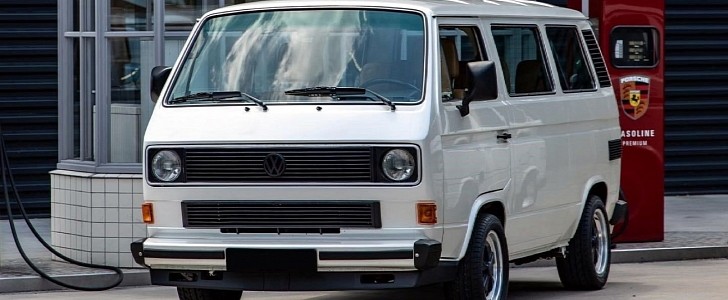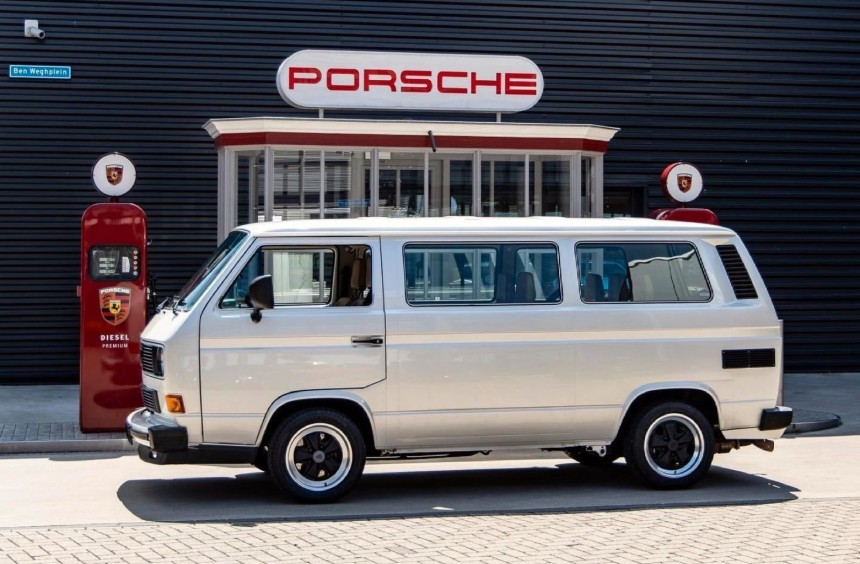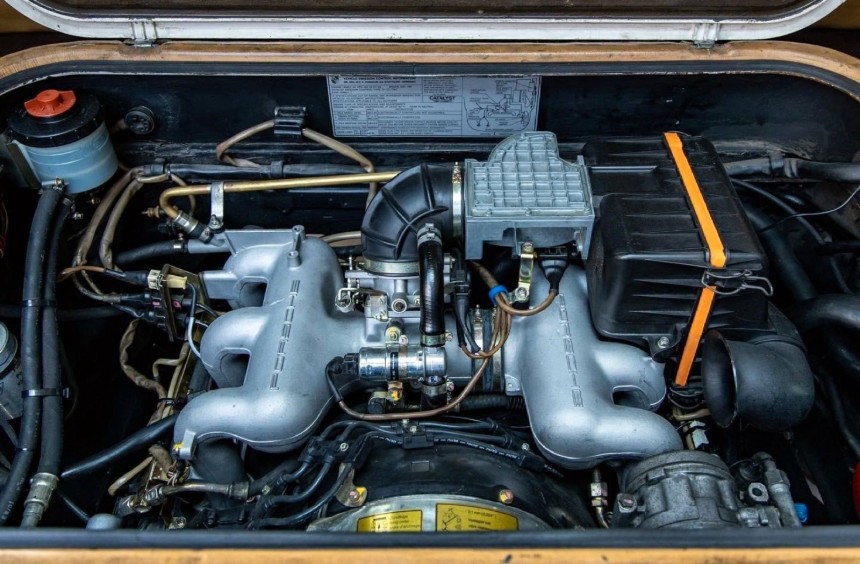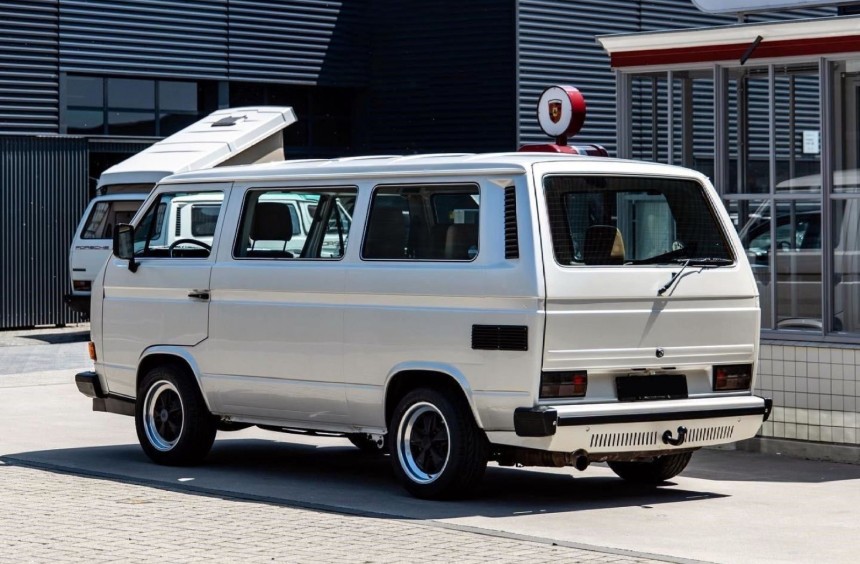Long before it angered purists by developing SUVs, crossovers, and a five-door, front-engine version of the 911, Porsche built a limited series of high-performance vans.
As the title and pictures suggest, the vans in question were all based on Volkswagen’s T3. Sold worldwide under various nameplates including Transporter, Caravelle, Microbus, and Vanagon, it was the third iteration of the iconic multipurpose van range that Volkswagen officially designated Type 2.
Introduced in 1979, it was a completely redesigned and improved vehicle available in various configurations. It quickly followed in its successor’s footsteps, becoming a legend for its versatility and reliability. It was such a trustworthy van, that VW’s South African branch kept it in production until 2002.
While many enthusiasts still remember the T3 as being a dependable workhorse, very few know that it also served as the base for Porsche’s first and only van.
In the early 1980s, the Zuffenhausen-based carmaker was known for two things: building one of the world’s most sought-after sports cars and dominating almost all forms of motorsport with either its innovative factory-built rides or its incredible engines.
During this period, Porsche was developing the 953, a comprehensively-modified, all-wheel-drive version of the 911 meant for Group B rally racing. This prototype dubbed 953 never got to compete in the World Rally Championship (WRC), but it went on to win the 1984 Paris-Dakar rally raid, then morphed into the mythical 959.
By now you might be wondering what all of this has to do with a high-performance van. Well, as the engineering team headed by Helmut Bot was performing endurance tests of the 953 in the deserts of Algeria, they realized that they desperately needed a spacious support vehicle that was fast enough to keep up with the prototype.
With no such vehicle available on the market, the team decided to get a T3 van and convert it into a Porsche by swapping out its original engine with a used 3.0-liter flat-six taken from a 911. The experiment proved to be successful and in the following years, a small fleet of more-refined vans designated Porsche B32 was built.
Based on the luxurious Carat version of the third-gen Transporter, these official support vehicles nicknamed Carrera Buses were equipped with 3.2-liter versions of the flat-six. Compared to the 3.0-liter of the initial test mule, the enlarged engines borrowed from the 911 SC provided extra torque and allowed the use of a higher final drive ratio. Speaking of which, each B32 also received a Porsche 915 five-speed transaxle with a limited-slip differential, reinforced driveshafts, stiffer springs, and shocks, as well as a new electrical system.
For the exterior, only a chin spoiler and a set of 16-inch Fuchs wheels from the 911 were added. Porsche even retained the T3’s original grille completes with a WV badge, yet it added its own logos close to the front wheel arches to let everyone know that this wasn’t a typical Transporter.
Inside, the upscale, Carat-level seats were left untouched, but a Porsche steering wheel and 911 SC gauges were added to complete the transformation.
With 230 hp on tap, almost twice as much as the most powerful, VW-built T3, the van was rumored to be capable of accelerating to 62 mph (100 kph) from a standstill in a little over eight seconds, reaching a top speed of 135 mph (217 kph). Moreover, with nine people on board and the air conditioning system running, it could maintain a speed of 116 mph (187 kph).
Although it wasn’t available in dealerships, the Carrera Bus was an official Porsche model and a few select customers were offered the chance to buy one, albeit for as much money as a new 911. It is unclear how many of them were actually built, with several official sources claiming that the figure stands at seven. However, it is believed that up to eight additional prototypes have been developed.
Some have survived to this day and the one featured in the gallery is currently listed for sale by Porsche Centrum Gelderland in the Netherlands. With 81,257 miles (130.770 km) on the odometer, the most outrageous sleeper that Porsche has ever built can be yours for “only” $358,777 (364,900 €).
Thanks to the YouTube channel Videos and pictures of VW Vanagon - t25 - T3 - Syncro – Doka, you can watch a B32 being driven properly on public roads in the video below.
Introduced in 1979, it was a completely redesigned and improved vehicle available in various configurations. It quickly followed in its successor’s footsteps, becoming a legend for its versatility and reliability. It was such a trustworthy van, that VW’s South African branch kept it in production until 2002.
While many enthusiasts still remember the T3 as being a dependable workhorse, very few know that it also served as the base for Porsche’s first and only van.
In the early 1980s, the Zuffenhausen-based carmaker was known for two things: building one of the world’s most sought-after sports cars and dominating almost all forms of motorsport with either its innovative factory-built rides or its incredible engines.
During this period, Porsche was developing the 953, a comprehensively-modified, all-wheel-drive version of the 911 meant for Group B rally racing. This prototype dubbed 953 never got to compete in the World Rally Championship (WRC), but it went on to win the 1984 Paris-Dakar rally raid, then morphed into the mythical 959.
With no such vehicle available on the market, the team decided to get a T3 van and convert it into a Porsche by swapping out its original engine with a used 3.0-liter flat-six taken from a 911. The experiment proved to be successful and in the following years, a small fleet of more-refined vans designated Porsche B32 was built.
Based on the luxurious Carat version of the third-gen Transporter, these official support vehicles nicknamed Carrera Buses were equipped with 3.2-liter versions of the flat-six. Compared to the 3.0-liter of the initial test mule, the enlarged engines borrowed from the 911 SC provided extra torque and allowed the use of a higher final drive ratio. Speaking of which, each B32 also received a Porsche 915 five-speed transaxle with a limited-slip differential, reinforced driveshafts, stiffer springs, and shocks, as well as a new electrical system.
Inside, the upscale, Carat-level seats were left untouched, but a Porsche steering wheel and 911 SC gauges were added to complete the transformation.
With 230 hp on tap, almost twice as much as the most powerful, VW-built T3, the van was rumored to be capable of accelerating to 62 mph (100 kph) from a standstill in a little over eight seconds, reaching a top speed of 135 mph (217 kph). Moreover, with nine people on board and the air conditioning system running, it could maintain a speed of 116 mph (187 kph).
Some have survived to this day and the one featured in the gallery is currently listed for sale by Porsche Centrum Gelderland in the Netherlands. With 81,257 miles (130.770 km) on the odometer, the most outrageous sleeper that Porsche has ever built can be yours for “only” $358,777 (364,900 €).
Thanks to the YouTube channel Videos and pictures of VW Vanagon - t25 - T3 - Syncro – Doka, you can watch a B32 being driven properly on public roads in the video below.



















